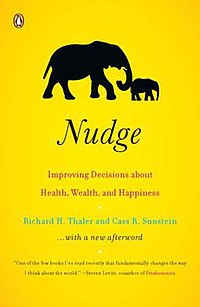A few years ago 2008 the book "Nudge" came out. Written by Cass Sunstein and Richard Thaler it promised that many small almost negligible changes to peoples behavior could add up to big changes.
Nudge: Improving Decisions about Health, Wealth, and Happiness

As Lean practitioners we are well versed in the idea that the sum of lots of small changes added together are often greater than a few big changes. Example of the ideas:
From BMJ +
Alcohol - Serve drinks in smaller glasses
Diet - Designate sections of supermarket trolleys for fruit and vegetables
From the book:
In hot weather, people depend on air conditioners, and many central air-conditioning systems need their filters changed regularly. If the filter isn’t changed, bad things can happen; for example, the system can freeze and break down. Unfortunately, it is not easy to remember when to change the filter, and not surprisingly, many people are left with huge repair bills. The solution is simple: people should be informed via a red light in a relevant and conspicuous place that the filter needs to be changed. Many contemporary cars notify people when the oil needs to be changed, and many new refrigerators have a warning light for their built-in water filters. The same can be done with air conditioners.
Question is, do any of these nudges work? From my own experience of being a backpacker in Australia in the 80s beer was served in small measures. Bottled beer is still served as stubbies, the name reflecting the small size of the bottle. Australians and I still managed to get drunk very easily. The idea of small bottles was explained to me as a way of keeping the beer cold. A small bottle was going to be emptied quicker, meaning you more often had a cold beer.
Designating an area of your shopping trolley (cart) for fruit and veg sounds like a good idea. In reality whats the likelihood of it working? Probably very little as there is nothing to stop the area being used for putting your donuts or ice cream in. Next time you are shopping, take a look at your trolley or other peoples. Trolleys get filled up. If you are doing a family shopping trip you do not have the luxury of space.
The third example, great first step towards
Jidoka. We have to ask; are the rest of the steps fulfilled? Where are the filters kept, can they be found, do the people know what the red light means, will they react and do they trust the light? How man people continue to drive their car when a warning light has come on, quickly learning its not critical (at least for a few days, weeks, months)?
The answer we know in Lean is discipline. We also know that it is the hardest part of implementing lean on the floor. With 5S it's not nudge it is Standardize and Sustain. If it was as easy as nudging all we would need to do was make sure that Set was done. That would be our nudge. From experience we know that an area will regress and our protection is discipline.
If you want to know more try this article in the Guardian:


